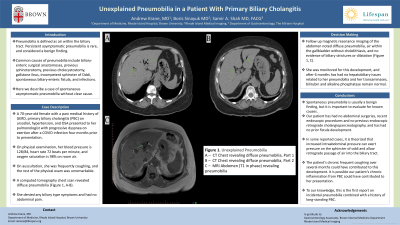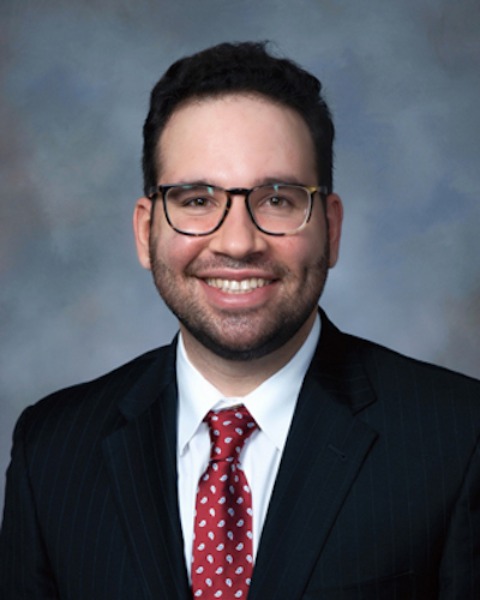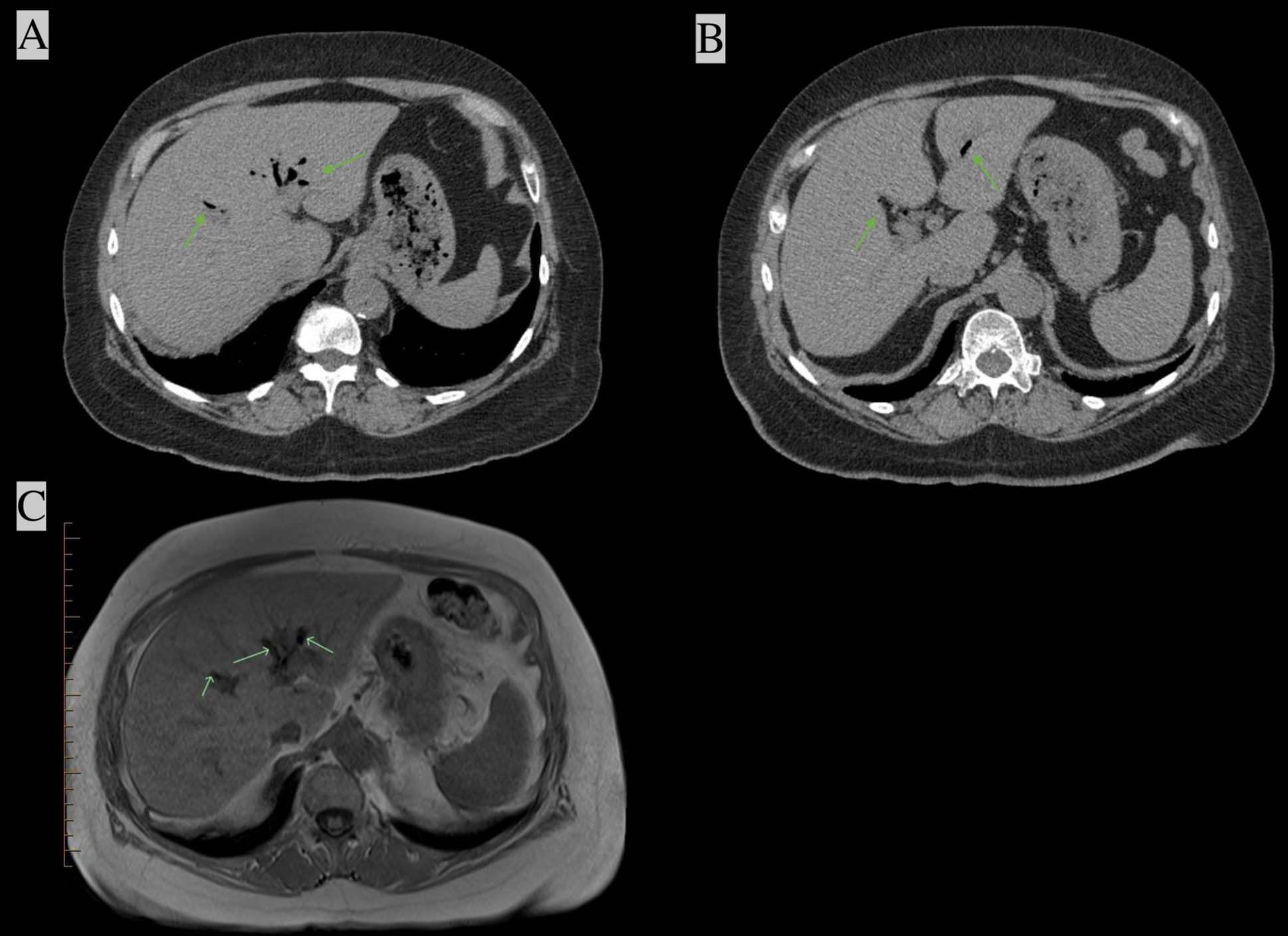Monday Poster Session
Category: Biliary/Pancreas
P1555 - Unexplained Pneumobilia in a Patient With Primary Biliary Cholangitis
Monday, October 23, 2023
10:30 AM - 4:15 PM PT
Location: Exhibit Hall

Has Audio

Andrew Krane, MD
Warren Alpert Medical School of Brown University
Providence, RI
Presenting Author(s)
Andrew Krane, MD1, Samir A. Shah, MD, FACG2, Boris Sinayuk, MD3
1Warren Alpert Medical School of Brown University, Providence, RI; 2Gastroenterology Associates, Inc., Providence, RI; 3Rhode Island Medical Imaging, Sharon, MA
Introduction: Pneumobilia is defined as air within the biliary tract. Persistent asymptomatic pneumobilia is rare, and considered a benign finding. Common causes of pneumobilia include biliary-enteric surgical anastomoses, previous sphincterotomy, previous cholecystostomy, gallstone ileus, incompetent sphincter of Oddi, spontaneous biliary-enteric fistula, and infections. Here we describe a case of spontaneous asymptomatic pneumobilia without clear cause.
Case Description/Methods: A 70-year-old female with a past medical history of Gastroesophageal reflux disease, primary biliary cholangitis (PBC) on ursodiol, hypertension, and obstructive sleep apnea presented to her pulmonologist with progressive dyspnea on exertion after a COVID infection four months prior to presentation. She has had no past abdominal surgeries or recent endoscopic procedures. On physical examination, her blood pressure is 128/84, heart rate 72 beats per minute, and oxygen saturation is 98% on room air. On auscultation, she was frequently coughing, and the rest of the physical exam was unremarkable. A computed tomography chest scan revealed diffuse pneumobilia (Figure 1, A-B). She denied any biliary type symptoms and had no abdominal pain. Follow up magnetic resonance imaging of the abdomen noted diffuse pneumobilia, air within the gallbladder without cholelithiasis, and no evidence of biliary strictures or dilatation (Figure 1, C). She was monitored for this development, and after 6 months has had no hepatobiliary issues related to her pneumobilia and her transaminases, bilirubin and alkaline phosphatase remain normal.
Discussion: Spontaneous pneumobilia is usually a benign finding, but it is important to evaluate for known causes. Our patient has had no abdominal surgeries, recent endoscopic procedures and no previous endoscopic retrograde cholangiopancreatography, and has had no prior fistula development. In some reported cases, it is theorized that increased intraabdominal pressure can exert pressure on the sphincter of oddi and allow retrograde passage of air into the biliary tract. The patient’s chronic frequent coughing over several months could have contributed to this development. It is possible our patient’s chronic inflammation from PBC could have contributed to her presentation. To our knowledge, this is the first report on incidental pneumobilia combined with a history of long-standing PBC.

Disclosures:
Andrew Krane, MD1, Samir A. Shah, MD, FACG2, Boris Sinayuk, MD3. P1555 - Unexplained Pneumobilia in a Patient With Primary Biliary Cholangitis, ACG 2023 Annual Scientific Meeting Abstracts. Vancouver, BC, Canada: American College of Gastroenterology.
1Warren Alpert Medical School of Brown University, Providence, RI; 2Gastroenterology Associates, Inc., Providence, RI; 3Rhode Island Medical Imaging, Sharon, MA
Introduction: Pneumobilia is defined as air within the biliary tract. Persistent asymptomatic pneumobilia is rare, and considered a benign finding. Common causes of pneumobilia include biliary-enteric surgical anastomoses, previous sphincterotomy, previous cholecystostomy, gallstone ileus, incompetent sphincter of Oddi, spontaneous biliary-enteric fistula, and infections. Here we describe a case of spontaneous asymptomatic pneumobilia without clear cause.
Case Description/Methods: A 70-year-old female with a past medical history of Gastroesophageal reflux disease, primary biliary cholangitis (PBC) on ursodiol, hypertension, and obstructive sleep apnea presented to her pulmonologist with progressive dyspnea on exertion after a COVID infection four months prior to presentation. She has had no past abdominal surgeries or recent endoscopic procedures. On physical examination, her blood pressure is 128/84, heart rate 72 beats per minute, and oxygen saturation is 98% on room air. On auscultation, she was frequently coughing, and the rest of the physical exam was unremarkable. A computed tomography chest scan revealed diffuse pneumobilia (Figure 1, A-B). She denied any biliary type symptoms and had no abdominal pain. Follow up magnetic resonance imaging of the abdomen noted diffuse pneumobilia, air within the gallbladder without cholelithiasis, and no evidence of biliary strictures or dilatation (Figure 1, C). She was monitored for this development, and after 6 months has had no hepatobiliary issues related to her pneumobilia and her transaminases, bilirubin and alkaline phosphatase remain normal.
Discussion: Spontaneous pneumobilia is usually a benign finding, but it is important to evaluate for known causes. Our patient has had no abdominal surgeries, recent endoscopic procedures and no previous endoscopic retrograde cholangiopancreatography, and has had no prior fistula development. In some reported cases, it is theorized that increased intraabdominal pressure can exert pressure on the sphincter of oddi and allow retrograde passage of air into the biliary tract. The patient’s chronic frequent coughing over several months could have contributed to this development. It is possible our patient’s chronic inflammation from PBC could have contributed to her presentation. To our knowledge, this is the first report on incidental pneumobilia combined with a history of long-standing PBC.

Figure: Figure 1: Unexplained Pneumobilia
A – CT Chest revealing diffuse pneumobilia, Part One
B – CT Chest revealing diffuse pneumobilia, Part Two
C – MRI Abdomen (T1 in phase) revealing pneumobilia
A – CT Chest revealing diffuse pneumobilia, Part One
B – CT Chest revealing diffuse pneumobilia, Part Two
C – MRI Abdomen (T1 in phase) revealing pneumobilia
Disclosures:
Andrew Krane indicated no relevant financial relationships.
Samir Shah indicated no relevant financial relationships.
Boris Sinayuk indicated no relevant financial relationships.
Andrew Krane, MD1, Samir A. Shah, MD, FACG2, Boris Sinayuk, MD3. P1555 - Unexplained Pneumobilia in a Patient With Primary Biliary Cholangitis, ACG 2023 Annual Scientific Meeting Abstracts. Vancouver, BC, Canada: American College of Gastroenterology.
